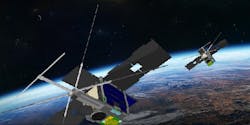UNSW Canberra Space advances satellite image processing with SiC telescopes
University of New South Wales (UNSW) Canberra Space (Canberra, NSW, Australia), a research team at a leading Australian University located at the Australian Defence Force Academy (ADFA), has ordered multiple CC Series telescopes from Aperture Optical Sciences (AOS; Meriden, CT). These telescopes provide the primary optical payload for the M2 satellite mission and support its role in developing world-class space capability in Australia.
RELATED ARTICLE: Metamaterial solar reflectors remove heat from spacecraft and satellites
The M2 mission is part of a research and development program supported by the Royal Australian Air Force which consists of a constellation of two advanced 6U Cubesats. The spacecraft have a suite of optical and RF remote sensing payloads to carry out a broad range of technology demonstration roles.
The novel approach to onboard data processing on the spacecraft aims to reduce the timeline between image acquisition and the ultimate delivery of information to decision makers.
"One of the primary goals of M2 is to develop a high-performance small spacecraft with imaging capability. We explored multiple options for the optical payload and found that the silicon carbide (SiC) telescopes from AOS provide us with the optimal combination of programmatic agility, coupled with low mass, thermal stability, and imaging quality," said professor Russell Boyce, director of UNSW Canberra Space. "We're impressed with their in-house capabilities for both design and manufacture of customized SiC optical payloads."
The CC Series is a new generation of high-performance telescopes for Cubesat and Small Satellite imaging and laser communication applications. Extensive use of SiC provides a telescope that is inherently athermal and low mass, providing consistent image quality and lowering launch costs.
SOURCE: Aperture Optical Sciences;http://www.apertureos.com/wp-content/uploads/2018/08/UNSW-AOS-Press-Release-2018-08-06-1.pdf
About the Author

Gail Overton
Senior Editor (2004-2020)
Gail has more than 30 years of engineering, marketing, product management, and editorial experience in the photonics and optical communications industry. Before joining the staff at Laser Focus World in 2004, she held many product management and product marketing roles in the fiber-optics industry, most notably at Hughes (El Segundo, CA), GTE Labs (Waltham, MA), Corning (Corning, NY), Photon Kinetics (Beaverton, OR), and Newport Corporation (Irvine, CA). During her marketing career, Gail published articles in WDM Solutions and Sensors magazine and traveled internationally to conduct product and sales training. Gail received her BS degree in physics, with an emphasis in optics, from San Diego State University in San Diego, CA in May 1986.
